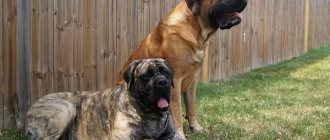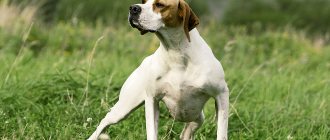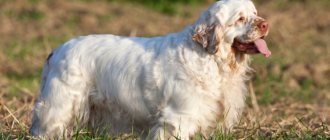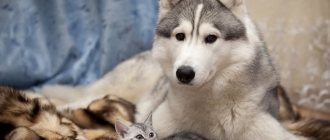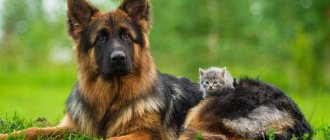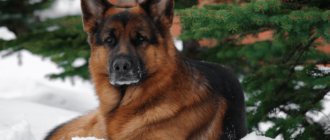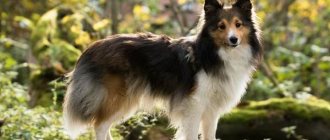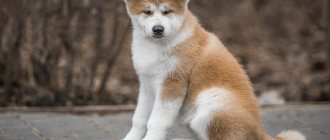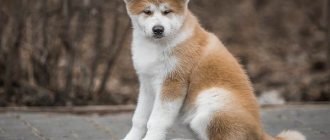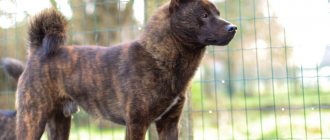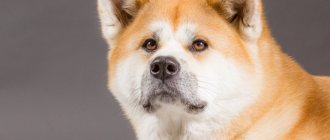Description of the English Mastiff breed
Popularity 144th place among 263 dog breeds
Lifespan:
9-11 years
Breed group:
Sentinels
Height:
males: from 76 cm, females: from 69 cm
Country of origin:
Great Britain
Average price:
30-35 thousand rubles
Weight:
males: about 72 kg, females: about 68 kg
Latest articles Cat health
Rabies vaccination for cats: choice of vaccine, necessity, schedule 01/22/2022 4 0 0
Selection and adaptation
TOP 20 best cat breeds for families with children 01/22/2022 25 0 0
Vaccinations and susceptibility to disease
The outwardly strong, powerful mastiff can suffer from some serious ailments. The most common ones include:
- Joint diseases (dysplasia and osteochondrosis). The physical activity of a Great Dane puppy is limited until it is one and a half years old so that the joints are fully formed and strengthened.
- Digestive problems (bloating, gastric volvulus, intestinal obstruction). You need to carefully select the diet and not physically burden the animal immediately after eating.
- Heart failure. Thickening of the walls of the heart leads to the fact that the organ is unable to pump blood. The dog's behavior becomes lethargic and apathetic. Sometimes they resort to medicinal treatment of the animal.
- Labored breathing. Due to the natural curvature of the nasal passages, the Great Dane sometimes finds it difficult to breathe. In especially severe cases, surgical intervention is resorted to.
The lifespan of an English Great Dane ranges from 6 to 10 years. And in order for the four-legged giant to spend them in health, the owner needs to vaccinate the animal against all kinds of infections on time:
- plague;
- parvovirus enteritis;
- parainfluenza;
- rabies;
- infectious hepatitis;
- leptospirosis;
- trichophytosis;
- coronavirus.
The first vaccination is given to the English Mastiff at 2 months of age. It is tolerated by dogs quite hard: with fever, general weakness and diarrhea. The second vaccination is carried out 3 weeks later. This time the puppy feels lighter.
At six months they are given a rabies vaccination and a complex vaccine against a group of diseases. If your puppy's teeth change during this period, you should wait it out.
At 12 months - a comprehensive vaccination, which is repeated every year thereafter.
Regular care, proper nutrition, daily walks with physical activity will make the life of your beloved pet happy and fulfilling.
Key facts
The English Mastiff is an ancient breed of dog. The territory of origin of this giant is present-day Great Britain.
Representatives of the breed are very calm and calm. The description of the English Mastiff breed says that they are strongly attached to their owners and love affection and care. Dogs prefer to spend quiet time at home instead of an active lifestyle. They are quite stubborn, so training requires a lot of effort and time.
Mastiffs are jealous, and this fact must be taken into account if there are small children or other pets in the family.
Despite its gentle and calm character, the English Mastiff is considered an excellent guard, protector and devoted friend. The characteristics of the English Mastiff breed include watchdog qualities combined with calmness and adequate behavior.
The health of this giant is vulnerable: the joints are especially affected, as in all large breeds. Therefore, when purchasing a puppy, you must ask for a health certificate from the parents of the litter. The average lifespan of an English Mastiff is 10 years. Some individuals live 2-3 years longer.
Breed traits
Breed traits (on a 5-point scale)
| English Mastiff | |||
| Activity | in the house | 1.8 | |
| on the street | 2.5 | ||
| Obedience | training | 3.7 | |
| strangers | 3.9 | ||
| Domination | in family | 1.7 | |
| over dogs | 2.8 | ||
| Defending your territory | from people | 2.6 | |
| from dogs | 3.1 | ||
| Sociability | in family | 4.7 | |
| with strangers | 3.1 | ||
| with dogs | 2.6 | ||
| Concentration | in family | 1.1 | |
| in front of strangers | 2.1 | ||
| with dogs | 2 | ||
| Aggressiveness | in family | 1.2 | |
| to strangers | 2.4 | ||
| to the dogs | 2.8 | ||
| to cats | 1.6 | ||
| Family behavior | calmness | 4.5 | |
| demand for affection | 4.5 | ||
| excitability | 2.9 | ||
| playfulness | 3.8 | ||
| excessive barking | 1.6 | ||
| behavioral breakdowns | 2.2 | ||
| Tolerance for children | up to 4 years | 3.8 | |
| over 4 years old | 4.2 | ||
| Institutional use | watchman | 4.5 | |
| bodyguard | 3 | ||
This breed is often compared to the following dog breeds: Cane Corso, Bullmastiff, Rottweiler, German Shepherd, Caucasian Shepherd.
Photos show what an English Mastiff looks like:
History of the origin of the English Mastiff
Today, two theories of the origin of the English mastiff are reliably known. According to the first theory, the ancestors of modern breeds were mastiffs of the molloid type, specially bred for hunting or conducting gladiator fights. The second version says that the country of origin of the mastiff is Great Britain.
The history of the formation of this breed has preserved many interesting facts. During the prosperous era of Egypt, Persia and Greece, mastiffs were used for transporting heavy things, hunting (both for entertainment and for prey) and guarding livestock.
Given the dog's appearance and fearlessness, it is easy to believe that they fought in wars. It is known that Alexander the Great owned a canine “army” numbering approximately fifty thousand dogs, which brought wild terror to his opponents.
Guy Julius Caesar was also involved in keeping the ancestors of the mastiff, but at that time the dogs were more reminiscent of lions in size and were quite aggressive. After the collapse of the Roman Empire, dogs quickly spread throughout Europe, and new breeds gradually began to be developed (Dogue de Bordeaux and Great Dane). These animals were kept mainly by rich people or served as royal guards. Ordinary people could not own and keep mastiffs because of their good appetite.
The mastiff's popularity increased in the thirteenth century thanks to the dog of the English nobleman Sir Peer Lee. During the fighting near Agincourt, the dog guarded the body of its wounded owner until help arrived. This story helped to look at mastiffs from a different perspective: people noticed in them, in addition to well-developed external characteristics, great devotion to their owners. This is how the development of the English line of this breed began.
During the Renaissance, another change in the concept of the breed occurred. It is known that Queen Elizabeth I preferred entertainment such as animal fights, which were popular. But mastiffs were slow and clumsy for this purpose. Taking this into account, to develop a fighting breed, they crossed a Molossian dog and a bulldog. Subsequently, a new breed of dog appeared called the bullmastiff.
Until the fifteenth century, English breeders were quite active in breeding animals for betting. And this lasted until the Molossian dogs were completely replaced. They gradually began to be forgotten, and it so happened that in the second half of the nineteenth century the breed was on the verge of complete extinction.
This did not happen thanks to the intervention of mastiff lovers, who created a special club and controlled the number of dogs and their selection to preserve the breed. In 1873, a “pupil” of the club named Tauras won at the international dog show, which was subsequently actively used to increase the number of Molossers. The only champion among puppies was Crown Prince, thanks to whom the English Mastiff line began and continues to this day.
During the First World War, the number of Molossians dropped sharply and by the mid-twentieth century reached approximately fifteen individuals, including one female. This happened due to the onset of times of famine: it was difficult and unprofitable to maintain an animal that ate as much as soldiers. The dogs began to be euthanized.
Thanks to Nora Dicken, who passionately loved mastiffs, the breed was preserved. She acquired the last remaining representatives in the United States and Canada and began working to increase the mastiff population with the support of fellow dog lovers.
Today there is no trace left in mastiffs of their bloodthirsty ancestors. In the USA, this breed is very popular due to its loyalty and unusually calm nature.
Character and behavior
The English Great Dane, which looks fierce and vicious, has a calm, gentle character. The kind, slobbering goofball dotes on all members of his family, including pets. However, he treats strangers with caution and suspicion.
The behavior of the English Mastiff can be characterized by the following epithets:
- nobility;
- calm;
- splendor;
- equilibrium;
- courage.
Not a trace remained of the aggressiveness and cruelty of his ancestors. This is the result of the work of skillful breeders who consciously tried to soften the ferocity of the character of the four-legged giant.
The Great Dane is distinguished by equanimity bordering on phlegmaticity. His restraint and endurance can be envied. It takes a lot of work to get a good-natured Great Dane excited. He will not bark over trifles.
The attachment of a Great Dane to its owner is sometimes aggravating in the literal sense of the word. The dog is not indifferent to strong hugs and will not miss the moment to jump onto the lap of its beloved owner. Everything would be fine if it weren’t for the impressive weight of the English Mastiff. Nursing such a “baby” is by no means easy.
The trembling and gentle giant has exemplary guard qualities. The Great Dane will not be the first to attack a stranger, but it will not allow the “enemy” to enter private territory. Having driven the enemy into a “corner”, a reliable watchman will wait for the owner to return.
As befits true aristocrats, the Great Dane loves to lie on the sofa for hours. Sport is not his element. Walking with the owner, the dog walks alongside him decorously and importantly, demonstrating to others his independence and power.
However, the calmness of the grenadier mastiff can disappear if he suddenly becomes interested in something. While running, a Great Dane can reach quite a high speed.
English mastiffs experience loneliness very painfully; they need constant communication. Leaving the giant bored for a long time, the owners risk returning to a destroyed apartment.
Children and English Great Dane
The English four-legged gentleman always has an excellent relationship with children, regardless of age. For the baby he will be a real nanny.
The only negative is that, due to its size, the Great Dane can accidentally knock a child down. Therefore, you should not leave the animal and baby unattended.
For a teenager, a Great Dane will be an excellent companion and reliable protection.
Appearance of the English Mastiff
General impression
The English Mastiff has a proportional appearance and a distinct gender type: males are large, massive, and females are lighter and more graceful. In the photo, the English Mastiff looks like a real athlete.
Head
The mastiff's head has a square outline.
Well-developed muscles are noticeable in the parietal, temporal and buccal regions. The skull itself has smooth outlines. If there is a protruding forehead and eyebrow arches, there is a smoothed occiput. The mastiff's muzzle is rectangular in shape and has a circumference 2.2 times smaller than the circumference of the head. Cheekbones are virtually absent. The cheeks protrude slightly due to their roundness. The nose is flattened and painted black. The nostrils are large and wide, mobile. The lips of mastiffs are closer to a rectangular shape, they are thick and fit tightly to the jaws. On the dog’s face you can see a kind of “mask”, characteristic only of this breed.
The animal's ears are adjacent to the cheeks on both sides. They are thin, medium in length and located on the top of the head.
The look of an “Englishman” from the outside may seem soft due to the setting of the eyes - low and wide. The iris is always hazel-colored and can have light or dark shades.
The jaws are square-shaped, and therefore the mastiff has a straight or scissor bite. Teeth are white. The lower incisors grow in a checkerboard pattern, and the canines, on the contrary, are widely spaced, so when the jaw is clenched, the teeth are not visible.
The mastiff's neck is slightly extended forward and has a diameter 2-3 cm less than the diameter of the skull. Thick skin in the throat area forms folds.
Torso
The English Mastiff has a long and powerful body. His chest is represented by convex ribs. The dog's back is wide and originates from the withers. The loin rises slightly above the back and there is a sloping croup. The abdomen and groin area are retracted.
Forelegs
The mastiff's front paws are spaced far apart. A small angle is formed between the chest and the elbow line. The slanted shoulders then flow into steep forearms and large pasterns. The front paws are powerful and round in shape with gathered toes.
Hind limbs
The English Mastiff's thighs are muscular and the shins are dry. Well defined joints. The hind legs are arched and have toes gathered into a ball.
Tail
The dog's tail is sickle-shaped, set high and tapered towards the end. At rest, the tail reaches the hock joints, and during movement it is at the level of the back.
Movements
The Mastiff primarily trots, but can gallop as speed increases. He moves freely, but sometimes his movements look loose. The back is always straight, regardless of the speed of movement.
Wool
The hair of the representatives of the breed is short, but quite thick. Compared to the undercoat, it is hard to the touch.
Color
English Mastiff colors always have tan. The color of the coat can be different: yellowish-brown, fawn, apricot, silver or brindle. The ears and “mask on the face” are always black, despite the general color of the coat.
Size
Females can grow up to 69 cm at the withers, while the male English Mastiff is taller and can reach 75 cm. The body weight of dogs reaches 69 kg in females, 87 kg in males.
The heavy weight of English Mastiffs puts a lot of stress on the joints, which is a reason to regularly take your pet to the veterinarian. The size of the English Mastiff is truly gigantic, and this must be taken into account when arranging a place in the house or in the yard.
Reproduction and lifespan
The English Mastiff is a very strong and beautiful dog, which is characterized by a sedentary lifestyle. The breeder must be able to distinguish it from the Dogue de Bordeaux. Representatives of these two breeds have many common features, both in appearance and in character. Unfortunately, this wonderful dog has a short lifespan. She lives no more than 10 years, more often 8-9, even with good care.
Males show special sexual interest in females closer to spring, especially when they are in heat. The breeder needs to wait at least 2-3 days, after which he must breed her with a male dog.
Mastiff puppies are born 65-70 days after mating. Usually no more than 6 individuals are born. Males are separated from females at approximately 1.5 months, that is, at the moment of the final formation of their reproductive system.
Important! It is impossible to breed dogs that are close relatives to each other, as they may give birth to unhealthy offspring.
Character of the English Mastiff
The English Mastiff is considered a calm, friendly dog. He is not characterized by mood swings. The dog is patient, the character of the English Mastiff is emotionally stable and reliable. The behavior shows nobility and the absence of puppy pranks. Being phlegmatic in behavior, he is devoted to his owners.
Mastiffs are considered true companions. Loneliness is hard to bear. During a prolonged absence of the owner due to idleness and boredom, they can cause damage to the home. It is important to understand: if you have a job that takes a lot of time, or if there is frequent travel (travel, business trips), it is better to refrain from adopting this breed.
The “English” are equally comfortable staying in an apartment and in a private house. They are not characterized by fuss and haste. During walks, mastiffs walk slowly, rarely running. You don’t need to use a leash - the dog will be nearby. Mastiffs are good guards, protecting territory and family members. It is not common for them to attack first, but this is not required.
The impressive appearance of the dog speaks volumes, and the stranger will be driven into a corner, where he will remain until the owners arrive. During a fight (if one happens), the dog will not concede victory to the enemy at the cost of his own life.
Dogs are wary of unfamiliar people and closely watch strangers. The only thing that the owner will have to compete for with a puppy or adult at home is a sleeping place. The main feature of the breed is its preference for comfort. Mastiffs climb onto the owner's sofa to rest without permission.
Families with small children should refrain from owning an English Mastiff for various reasons. Firstly, this is due to the size of the animal: during play, it can accidentally injure a child. Secondly, the dog’s jealousy. In this case, it is better to get a Bichon Frize, Poodle or Airedale Terrier. These breeds are compact and will not cause serious harm, content to play even with small children.
If other animals live in a house with Molosser representatives, it’s okay. The “English” can easily put up with cats, rodents, and birds. Aggression may appear if another pet was adopted much later. In this case, you need to be careful because of the danger of a conflict between the dog and the “rival”; this could end in the death of the other.
The English Mastiff needs to be walked for a long time in any weather and time of year. It's hard to get them to run. In winter, at low temperatures, they feel comfortable thanks to their thick undercoat and are in no hurry to go home. However, in the summer heat, it is better to avoid prolonged exposure to the sun to prevent your dog from overheating.
When choosing a pet, it is important to remember that the character in the future depends on the training and upbringing of the owner. The main goal is to raise a peace-loving and balanced animal that will be a loyal friend.
History of origin
The English Mastiff is a dog breed from Great Britain, classified as arched and officially recognized more than a century ago. She received her first standard in 1883. But even before that, one of the largest dogs in the world managed to prove itself in the best way. The ancestors of mastiffs were known back in the times of the greatness of Babylon, Assyria, and Persia. The Molossians of that era had a rawer bone structure and a heavier gait; they were used as guards and performed in military campaigns.
It is assumed that the ancestors of the Old English Mastiffs appeared in Great Britain during the migration of Celtic tribes in the 4th–3rd centuries BC. With the arrival of the Romans on the island, their historians wrote a lot about the large, massive dogs used by the Britons. The special ferocity of these animals, their physical strength and fearlessness were noted. It is not surprising that mastiffs, as the breed began to be called during the time of Julius Caesar, began to be actively imported into the Roman Empire, and a special position for selecting animals even appeared at court. Here, English giants began to be used in gladiatorial battles, along with legionnaires. Subsequently, the development of the breed was influenced by a new military invasion of the island - the arrival of the Saxons in 407 AD led to an influx of fresh blood.
Among the imported animals, gafaelgi stood out - dogs used for hunting purposes to bait animals during the hunt. The mixed breed, mixed with the mastiffs previously present on the island, was called costog. The dogs had medium-length hair, dark color and a very ferocious character. It was in this form that the animals existed until the 11th century, when the Normans invaded Great Britain.
Representatives of continental Europe at that time had their favorites - Alans or hunting mastiffs. Their mixing with Proto-Molossians of local breeding resulted in splitting into several breed types at once. Dogs were valued for their viciousness, fearlessness, and large size. The old-style bandogs, which appeared thanks to the Saxons, also retained their popularity. They were used to perform guard functions; thanks to their dark color, they were invisible in the dark.
Transition to purebred breeding
As an independent breed, the English mastiff began to emerge after 1415, after the infamous battle of Agincourt, in which dogs fought along with their owners and were ready to give their lives for the British crown. The deceased pet of Sir Piers Lee, owner of the Lime Hall estate, was given the same military honors as her owner at the behest of King Henry IV. Subsequently, her line of descendants became one of the three main nurseries in Great Britain. In addition, the Gattons family and the Duke of Devonshire were involved in the selection of mastiffs after the 18th century. Until 1835, the main purpose of the breed was animal baiting, in particular, dogs fought with bears and successfully defeated them.
New story
Modern English mastiffs bear little resemblance to their distant ancestors. Their disappearance has led to a renewed interest among plant breeders in this lost British treasure. When restoring the breed, the blood of the following types of dogs was used:
American and Alpine Mastiffs;
The first dog of the modern type of the breed was exhibited in 1873. Thanks to the efforts of the club, which brought together lovers of the Old English Mastiff, the animal acquired a noble appearance and retained the recognizable features of the Molosser. Male Tauras from the Nanbury kennel, who participated in the show, became its winner. But the ancestor of the modern English mastiff is considered to be his descendant named Crown Prince. Subsequently, dogs born in this line repeatedly became champions and winners of exhibitions.
By 1906, the new population of English Mastiffs required the creation of a standard to accommodate changes in phenotype. Long-haired, spotted, black and gray animals began to be culled. Throughout the 20th century, the population of the breed remained very small; after World War II, it remained mainly in the United States.
Education and training
It is important to start raising and training an English Mastiff earlier, preferably in the first days of the pet’s arrival at home. In the process of raising a dog, it is necessary to learn who is in charge in the family - and this is the owner, but not the dog. It is not permissible for a trained “Englishman” to be willful or show aggression. When conducting training, avoid cruelty and physical punishment; on the contrary, use affection and tenderness. The most important thing is to find a middle ground.
Mastiffs perform differently in training. Dogs may want to please the owner and remember the exercise with lightning speed - or become stubborn. Be sure to reinforce the material you have learned, constantly praise and encourage your pet for its success. Training should not last more than an hour or be for your entertainment. Mastiffs will quickly understand this and stop listening to you.
Do not forget that representatives of this breed have good intelligence, and they easily find a weak point in the owner and then manipulate him. Therefore, if some problems arise, it is better to contact a professional trainer.
Key points in training
The main thing in training is to interest the pet and not try to force it to perform tricks if the animal is not interested in it. It is important to understand how you can motivate your dog. Usually these are all kinds of goodies, but here it is important not to spoil the animal.
It is best to have an experienced person perform all the stunts. But even a beginner will be able to teach his pet the very basics of behavior with the help of gentle words and encouragement.
Training should begin at 7 months. It is important not to procrastinate and take breaks. First, the pace of the lesson is set, and after that you can start teaching the dog basic commands. Of course, it is best to entrust the animal to a professional trainer.
Read about how to properly train a dog in the article: “Training a puppy: effective methods from dog handlers, learning commands at home.”
English Mastiff Health and Diseases
Possible diseases
The English Mastiff has good health and a long life expectancy. But they also have weaknesses. The most common diseases include:
- Joint damage (hip dysplasia, knee osteoarthritis). This is due to their structure and heavy weight.
- Diseases of the gastrointestinal tract (volvulus of the intestines and stomach, obstruction, bloating). Flatulence is the most common problem in this breed.
- Diseases of the cardiovascular system (stretching of the heart walls).
- Diseases of the urinary system (urolithiasis).
- Diseases of the organs of vision (eversion and entropion of the eyelid, redness of the eyes, cataracts). These features are related to the location of the eyes.
If symptoms of the disease appear in your pet, you should not self-medicate, but rather consult a veterinarian. This will improve the health and prolong the life of your pet.
Reproductive health
Bitches come into heat quite early: from 6 to 12 months.
But full puberty occurs only at two years of age - it is from this time that a dog can be bred to produce offspring. The same applies to males - the first mating should not occur too early. Labor in mastiffs can last from several hours to a day, this is normal. Protect newborn puppies from excessive attention from the mother - she can torture them and the offspring will die.
Nutrition
Fortunately for those who decide to have this large pet, the dog is absolutely not picky about what it eats. It should be remembered that until the dog is one year old, he eats three times a day, and then the number of feedings is reduced to two a day. Buying dry food for dogs of this breed is a good option, they will eat it with pleasure.
The main principles are adherence to the food regime and maintaining a balanced diet, the inadmissibility of overfeeding the dog, because weight greatly affects the joints and musculoskeletal system. Obesity can provoke both diseases associated with the skeletal system and other ailments.
English Mastiff puppies
As in any other breed, variations on the topic of “nutritional composition” are acceptable here. It all depends on how convenient it is for the owners to prepare separate dishes for their four-legged friend every day. If time does not allow, you can resort to store-bought feed, but it is important that their quality is not lower than the premium category.
In the case of natural products, it is important that the basis of the diet contains animal protein, that is, meat. Bones require calcium, so sea fish is also acceptable, and fermented milk products include cottage cheese. Don't ignore vegetables either. Breeders say that the mastiff perceives carrots and cucumbers as treats. But it’s better to stop with real treats like candies and other sweets forever.
Features of feeding and diet
The English Mastiff has an impressive size and a good appetite. This is financially very costly. There are two types of diet:
- ready-made food – contains the necessary microelements and vitamins for proper nutrition and development;
- natural food.
In the latter case, it is important to develop a pet menu taking into account the addition of necessary microelements. Additionally, you need to choose a vitamin-mineral complex.
It is impossible to combine two diets at the same time (i.e., alternate food and natural food). This will provoke dysfunction of the gastrointestinal tract and negatively affect the dog’s health.
How many times a day should you feed your dog? It depends on age:
- puppies up to 4 months are fed 5 times a day; babies aged 4 to 6 months – 4 times a day; from 6 months to 1 year, feed 3 times a day;
- Adults feed 2 times a day.
It is necessary to exclude sweets, smoked meats, beans, mushrooms, berries containing seeds, boiled or raw river fish, tubular bones, lamb, pork, and milk from the pet’s diet (allowed for puppies up to 4 months).
Do not add spices to your dog's food and try not to give treats from the table. The mastiff should have access to unboiled water. Most breeders are inclined to believe that bottled water is preferable.
Mating
Typically, girls of this breed come into heat before the age of 1 year. However, this is not a suitable age for mating, since if she becomes pregnant, she simply will not be able to bear healthy offspring. You need to wait 2-3 heats to make sure that the animal’s body is working normally.
Mastiff males are allowed to mate from 12 months. It is important to consider the size of the dog. Small animals are allowed to breed earlier.
Before performing the mating procedure itself, you need to choose a suitable day and agree in advance with the owner of the male. Usually the bitch is brought to the dog on the territory where the animals get to know each other.
It is important to track the period of sexual heat of the animal. This is the most suitable time for mating. To know when is the best time to breed an animal, it is best to consult an expert because each dog has its own characteristics. If you are not sure that everything will go well, it is better to invite a specialist for the first time. It will help prevent possible difficulties.
The main thing is that before mating the animal is well-fed and has a good walk.
A dog's pregnancy lasts from 60 to 70 days. Childbirth is usually quite difficult. On average, a female dog can give birth to up to 5 puppies .
Care and maintenance
Keeping and caring for English mastiffs is quite simple and does not require special skills, and all thanks to the dog’s short hair. The pet must be brushed once every 2-3 weeks. During the shedding period, you will have to brush more often using a stiff bristle brush. To add shine to the coat, you can use a cloth or a piece of suede and periodically wipe the sides and back of the dog.
The animal is bathed rarely and, if necessary, using special pet shampoos, so as not to provoke hair loss and skin irritation. For more frequent care, you can use dry shampoo.
It is very important to keep your pet's face clean. Carry out regular eye examinations, wipe with a solution of chamomile or strong tea. If discharge of any color appears from the eyes, you should contact your veterinarian.
After a walk, ears should always be wiped with a damp cloth and inspected. Using a damp cotton pad or soft cloth, you need to regularly clean the folds on the face and neck: food particles, dust, grease, and dirt can accumulate there.
It is recommended to clean your teeth and oral cavity once a week using a toothbrush, a special finger attachment, or a bandage folded in several layers. Claws must be periodically removed with pruning shears, even though dogs' claws wear down when walking under heavy weight.
Mastiffs need long walks, but in hot weather it is better to reduce the time spent in the sun to a minimum, since mastiffs have a brachycephalic muzzle, which makes it difficult for the dog to breathe and can lead to overheating of the body.
Health
Mastiff at the age of 10 years
The most common and dangerous diseases in mastiffs include:
Less dangerous diseases are:
- eye diseases: iris cyst, entropion, “cherry eye”, corneal dystrophy;
- skin diseases: allergic reactions;
- joint diseases: arthritis, hypertrophic osteodystrophy, spinal spondylosis;
Sleeping Mastiff
- diseases of the reproductive organs: cryptorchidism, unilateral cryptorchidism, vaginal hyperplasia.
- cardiovascular diseases: pulmonary stenosis, heart murmurs;
- other: hernias, Von Willebrand's disease.
Tips for choosing a puppy
To purchase a puppy with good health and genetics, it is better to contact an official nursery. The most important criterion for choosing an English Mastiff dog is character. If there are children in the family, it is better to purchase a puppy with a less dominant character, so that the child and the dog do not compete for authority and love in the family. It must be remembered that an overly timid character in a dog is not the best sign.
This rule must be taken into account by families who already have pets, including dogs. In such a situation, it is better to take a puppy of the opposite sex. Mastiffs with a dominant type of character can only be handled by owners who have experience in keeping large breed dogs and who know how to approach them. It is important to remember that love and proper training will turn even a born leader into an obedient and friendly pet.
The best age to buy a baby is from 1.5 to 3 months. At this time, English Mastiff puppies have a stable psyche and are ready for independent life.
Dog handlers recommend that before choosing and buying a puppy, you study the conditions of its keeping, look at the parents, check documents and vaccination certificates. A healthy puppy should have shiny fur, clear eyes, and a cool and moist nose. If you are in doubt about your choice, it is better to consult a dog handler, since the cost of these dogs is rather high.
Appearance
English mastiffs in nature photo
– Advertising –
This breed is a large type of dog. As adults, English Mastiffs reach the waist height of the average man. The height of males reaches 76-91 centimeters, bitches – 70-91 centimeters.
Boys tend to be heavier and weigh 68-110 kilograms, while girls weigh 54-91 kilograms. Below is the average weight of dogs at different ages:
| Age | Male | bitch |
| 4 weeks | 6,8 | 5,8 |
| 8 weeks | 13,1 | 10,8 |
| 9 weeks | 14,9 | 13,1 |
| 10 weeks | 16,3 | 14,5 |
| 11 weeks | 18,1 | 16,3 |
| 3 months | 20,4 | 17,6 |
| 4 months | 27,2 | 22,6 |
| 5 months | 36,2 | 29,4 |
| 6 months | 45,3 | 36,2 |
| 7 months | 56,6 | 40,8 |
| 8 months | 63,5 | 45,3 |
| 9 months | 70,3 | 49,8 |
| 10 months | 74,8 | 50,8 |
| 11 months | 77,1 | 52,1 |
| 12 months | 79,3 | 54,4 |
| 13 months | 81,6 | 55,3 |
| 14 months | 83,9 | 56,6 |
| 15 months | 85,2 | 56,6 |
| 16 months | 85,7 | 57,1 |
| 2 years | 92,9 | 61,2 |
| 3 years | 97,5-102,0 | 70,3-81,6 |
| 4 years | 99,7-104,3 | 72,5-86,1 |
| 5 years | 99,7-106,5 | 77,1-90,7 |
Most English Mastiffs are fawn to apricot in color. Also, there are individuals of brindle and silver colors. Their eye color ranges from brown to dark brown.
A photo of the breed is presented below.
How much does an English Mastiff cost?
The price of an English mastiff depends on many factors, and the average amount starts from 30,000 rubles. The price is influenced by the gender of the dog, compliance with standards, the location of the nursery, pedigree and degree of title of the parents are taken into account. Cull puppies that will not participate in dog shows are sold for a small price.
At the same time, the price of a puppy with a good pedigree and titled parents skyrockets. Here you need to decide for what purpose the animal is needed: to participate in exhibitions or just as a friend.
In any of these two cases, you will not lose, since you will have a pet that will brighten up your everyday life and become a favorite of the whole family.
Do you like the article? 0
Where can I buy
If you decide to buy an English Mastiff puppy, then you have several ways to get the dog you want. First of all , buy an English Mastiff puppy from a kennel
, we have such nurseries in our country, and in quite large quantities. The second way is to find advertisements for the sale of dogs of this breed secondhand. Such advertisements often come across on the Internet; you will only need to choose a city closer to you or even your own city and contact the breeder.
All in all, buy an english mastiff puppy
- no problem. Each of these methods has its own advantages and disadvantages, well, let's look at the first method. So, you came to the kennel, it’s clean, the puppies are running around happy, it means everything is fine with the kennel and, most importantly, everything is fine with the puppies and this is a definite plus.
The downside awaits you a little further - the price of an English Mastiff
, a puppy from a kennel can cost 700-800 US dollars, you must admit, not every citizen of our country has that kind of money to buy a dog.
If you buy a puppy secondhand, you can save several hundred American dead presidents for your family's budget. But such a puppy will not necessarily meet all breed standards. Before buying this dog, be sure to read reviews about the English Mastiff
on the Internet, this dog may not be suitable for you. You won't get along in character.
Video
https://www.youtube.com/embed/
* We invite you to watch a video about the Tibetan Mastiff breed. In fact, in front of you is a playlist in which you can select and watch any of 20 videos about a given dog breed by simply clicking on the button in the upper right corner of the window. In addition, the material contains quite a lot of photos. By looking at them you can find out what a Tibetan Mastiff looks like.
| In this article: |
The Tibetan Mastiff is considered one of the rarest, most beautiful and ancient dog breeds. Many draw an analogy between mastiffs and lions. They do have some similarities. Huge size, courage, fearlessness, incredible intelligence and intelligence are inherent in these dogs. Huge dogs are very freedom-loving, but at the same time they have great endurance and friendliness. The breed got its name due to its origin. These dogs were bred in Tibet. However, the exact origin still causes controversy and questions among zoologists.
| Material content: |
Application and training
English thugs are taken in as companions. But they are also excellent watchmen and security guards. Moreover, they do not need courses in protective guard training: they protect the territory and their owners instinctively. But, if you wish, you can take classes.
The animal's appearance alone will scare off ill-wishers. It’s not for nothing that even owners of six-month-old puppies are asked “do you happen to have a horse?” In addition, dogs are wary of strangers: they stand between the owner and the stranger, and do not leave until they are sure that their person is safe.
OKD will be required. English Mastiff puppies should undergo this test at 6 – 8 months. The breed's characteristics describe the dogs as intelligent, obedient and diligent. Having learned the command, they will carry it out unquestioningly. But the dogs do everything slowly, so you have to be patient.
Results
By listing all the main thoughts from this article, the following theses can be formed:
- This breed is excellent for guarding territory, but is extremely silent.
- Has a highly developed defender mechanism. But without proper upbringing, he can show aggression towards others.
- Young individuals must undergo special training. This is explained by the fact that managing such a large dog is quite difficult.
- The dog is quite lazy and prone to gaining excess weight. Daily walks help solve the problem.
- Not suitable for living on a chain. An animal separated from its household becomes depressed.
- It is necessary to buy a puppy only from trusted and well-known nurseries. Of course, this can be quite expensive. But a professional breeder will help you understand all the intricacies of keeping an English Dane.
- Adults are excellent companions. They are calmer, quieter and more manageable.
- Sufficiently short fur sheds heavily.
- It gets along well in an apartment or private house with a small yard. But in this case, you need to walk the dog at least 3 hours a day.
- The animal gets along well with children and the elderly. At the same time, it is quite bulky and can accidentally drop or knock over a child or an elderly person.
- Has increased salivation. But significantly less than other breeds with a similar jaw structure.
- When walking an animal, it is necessary to avoid overheating. It can lead to the death of the dog.
- And yes. The English Mastiff snores extremely loudly.
Relationships with children and animals
A well-mannered mastiff does not show aggression without a reason. The key word is “well-mannered.” The puppy is socialized from the first days of life, otherwise he will become withdrawn, extremely distrustful, and even cruel.
At first, breeders teach them how to interact with people. They pet the puppies as often as possible, talk to them, and carry the babies in their arms.
The owner’s task is to introduce the puppy to possible situations and living beings with which the pet will have to come into contact. He is taught to communicate with other people, dogs and other pets.
But the main thing is that the dog must learn the rules of behavior with children. If an English Mastiff dog gets to know them as a puppy, she will allow the kids to do anything with her - pull the ears, tail, pull back the jowls and even ride on herself.
English Mastiffs are not recommended for families with children under 7 - 12 years of age. Animals will not harm children on purpose. But due to their large dimensions, they can accidentally push, hit or crush a child.
Mastiffs get along well with other dogs, especially dogs of the same breed. Conflicts sometimes arise between male dogs, but they are easy to stop.
It’s more difficult with cats and other pets. Dogs are not cattle dogs; they do not have an innate loyalty to small animals. They get along together if they grew up side by side. But bringing a kitten into a home where there is an adult mastiff is a mistake. Dogs rarely take a new pet calmly and can easily devour the baby.
Proper care of the Tibetan Mastiff
The ideal place to keep a Tibetan would be a private house with a large local area. The dog needs to have a spacious enclosure and kennel. Dogs of this breed do not tolerate hot, humid climates very well.
Mastiffs need daily exercise, so they need to be walked at least twice a day for 40-50 minutes. This should be done daily
It is important to give the dog the opportunity to frolic. Tibetans enjoy playing with other dogs that are not very different in size (Malamute, German Wolfhound)
Puppies grow quite quickly and gain weight, but they achieve full physical development only after 2 years. The owner must take into account that despite its rather impressive size, the pet remains a puppy for some time. All giant breeds have joint problems. To avoid this, it is better to limit the time of walking and free time in the yard for up to a year.
You need to regularly exercise and communicate with your dog. A dog that does not receive physical and emotional relief will be sad, but not quietly and silently, but noisily destroying everything around.
Shedding among Tibetans occurs once a year, and in some climatic conditions does not occur at all. You need to take care of your four-legged friend’s fur so that it looks neat and doesn’t get tangled. The dog must be combed at least once every three days. Representatives of the breed do not have a specific smell, so they are bathed only when necessary.
The animal's claws and teeth also need care. Claws should be trimmed 2-3 times a month as they grow. It is recommended to brush your teeth after one or two days. Considering the considerable size of the pet, it is necessary to accustom it to hygiene procedures from puppyhood.
Feeding
For large breed dogs, proper nutrition plays a significant role. Tibetans have excellent appetites and consume a lot of food, especially as they grow. The diet should be complete and balanced.
As the dog matures, it eats much less. Their daily intake is less than that of Boxers or Labradors. Tibetans are not prone to overeating; they know when to stop. The dog should always have access to clean water in the required quantity. Rules to follow:
When feeding dry diets, do not soak the food in milk or water. You cannot suddenly change the brand of food without a serious reason.
This can negatively affect the development of the quadruped. You should not give your dog hot or cold food. When purchasing food, it is important to ensure that it matches the size and height. You should not give your dog fatty foods, smoked meats and river fish. If you feed a Tibetan with natural products, the diet should include:
If a Tibetan is fed natural products, the diet should include:
- meat;
- offal;
- sea fish;
- buckwheat and rice porridge (preferably with vegetable oil);
- boiled eggs (twice a week);
- vegetables, boiled and raw;
- fruits.
Tips for choosing a puppy
Tibetan breed puppies are a rarity and a curiosity. This is an expensive pleasure. Even if we do not take into account the financial side of the issue (they are not cheap), the acquisition of such an exclusive pet is complicated by some nuances:
- Most often, breeding puppies are sold under a co-ownership agreement. The breeder, even after purchasing the dog, remains its co-owner with equal rights.
- Individuals with minor defects are sold with the obligatory condition that the dog will be castrated/sterilized. Provided that you do not intend to breed, this option may be quite acceptable.
- When applying for the status of a breeder, you will have to justify your desire and back it up with financial guarantees, knowledge and experience.
- To get a puppy, you will need to reserve it and wait in line.
You can, of course, buy a Tibetan baby without documents “from your own hands”
Before you do this, it is important to consider that:
- Often “breeders” justify the lack of documents by the high cost, but this is not true. Registration of breeding documents does not entail serious financial obligations, especially in comparison with how much the puppy costs.
- Without documents, any dog is considered mongrel.
- A mongrel dog cannot be used in breeding the breed.
- A huge mongrel dog can be purchased for free at the shelter. However, there are no guarantees that the dog will be calm and sane. It’s scary to even imagine what an excitable giant, a half-breed, could be capable of.
What the formidable mask hides: character traits
The intimidating appearance and size of English mastiffs scares away novice dog breeders. But inside the formidable dogs hide loving and devoted friends.
Pets are harmless. They adore all family members. Animals are not touchy; they subtly sense people’s moods and understand when they are out of sorts. Dogs do not tolerate cruelty, but they will forgive rudeness if the owner accidentally loses his temper.
But outsiders need to be careful. Mastiffs will not harm family members, but are extremely wary of strangers. You should not go hugging a dog who is calmly walking next to the owner - the pet may perceive this as aggression or a threat to the owner. And she will fiercely defend him and herself.
